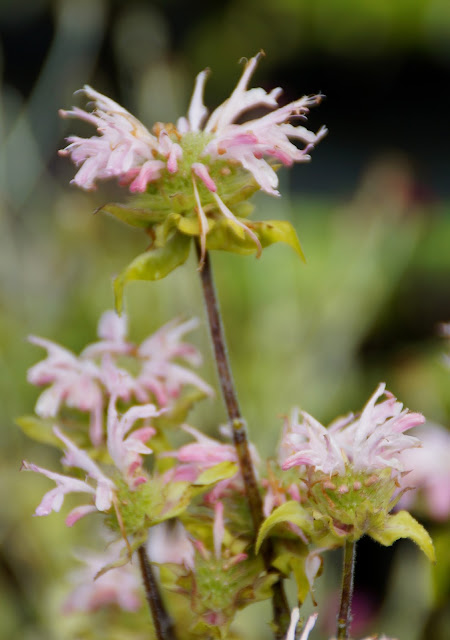When I think of Monarda, I always remember the first time I came across the genus as a student at the National Trust for Scotland Threave School of Gardening. They grew in huge patches in the herbaceous borders in front of the house. These were the scarlet flowered ones, probably M. 'Cambridge Scarlet', not only were they memorable for their colour but the lovely almost spicy scent of flowers and leaves. Now a days Monardas come in a huge range of pinks, purples, whites and reds, but the scarlet ones will always be my favourite.
 |
| Monarda 'Cambridge Scarlet' |
Monarda originate from America and are commonly known as Bergamot or Bee-balm. In the wild they can be found on hillsides, moist meadows and forest clearings. They grow well in sunny or slightly shady situations and moist to well drained soil and as their common name suggests attract plenty of bees. If you like to encourage wildlife in the garden, this is another reason to plant Monarda. Growing between two and three feet they will support themselves and require little attention through the growing season.
 |
| An unusual light pink, Monarda 'Fishes' |
Planted in a mixed border in the sun Monarda adds a different flower shape between umbels, spires and grasses becoming a focal point from mid to late summer. Plant it where you can brush past and smell the leaves and flowers when crushed. The native Americans used it widely for medicinal purposes. It's minty spicy flavour was also used as an accompaniment to game dishes.
 |
| Monarda 'Marshall's Delight' |
The flowers are arranged in whorls, tightly packed together and arranged around the stem at intervals all the way up. They last well in flower arrangements ans vases and even once they are passed their summer glory, the old seedheads work well in dried arrangements through winter or left uncut in the garden to give structure, especially with dusted with frost.
 |
| Monarda 'Mohawk' |
Plant Monardas in the herbacious border with other late summer flowering perennials such as Phlox, the dusky pastel shades of both Genus work well together. Plant hardy Geraniums in front to flower early in the season as the Monards are growing. The also work well with grasses, such as soft flowered Deschampsia or Molinias.
 |
| Close up of Monarda 'Mohawk' |
If you have a space in a border I would recommend you give these plants a go, for their scent, structure and attractiveness to bees. Which one to go for depends on your colour preference. The Quirky Bird recommends the following:
Monarda 'Cambridge Scarlet'
Scarlet, showy and traditional. My favourite, flowering in July and growing to 2 feet.
Monarda 'Croftway Pink'
A lovely mid pink variety that flowers from July, robust and mingles well with purples, whites and blues in the border.
Monarda 'Marshall's Delight'
A tall purple cultivar that stands well with it's velvety pinky-purple flowers. Mildew resistant growing to 3 feet.
Monarda 'Adam'
Another tall variety growing to 3 feet, with cherry red flowers that last from mid summer into early autumn,
Monarda 'Violet Queen'
A lovely purple tinged pink variety growing to 3 feet with soft slightly hairy leaves.
Monarda 'Fishes'
An extra tall Monarda at 4 feet with pink and white flowers. Unusual and worth trying.
There are many other cultivars available to grow in your garden. We have several varieties available from the nursery including M. 'Adam', M. 'Aquarius', M. Blaustrumpf', M. 'Cambridge Scarlet', M. Fishes', M. 'Gardenview Scarlet', M. 'Marshall's Delight', M. 'Mohawk', M. 'Scorpian' and M. 'Violet Queen. I will be adding more to our stock list as time goes on.
 |
| Monarda 'Scorpian' |
Find us on Facebook:
www.quercusgardenplants.co.uk
All contents and photographs © Rona, unauthorised reproduction & use of these images is strictly forbidden
All contents and photographs © Rona, unauthorised reproduction & use of these images is strictly forbidden
That was a really interesting post, Rona! When we first moved here, there were the red Monarda in the garden, but they disappeared. Probably pulled up before I took an interest in gardening. I think that they would look good in the new border that I am planning for next year. I must look out for them.
ReplyDeleteLeanne xx
Thanks Leanne, they are definitely worth trying and usually easy to find these days :) xx
ReplyDeleteEverything a gardener needs to know about these beauties Rona. Sadly they don't do well in my garden - just one of many on a long list! Love M. Cambridge Scarlet - what a super shot off it too.
ReplyDeleteThanks Angie, they can be prone to mildew too which makes them unsightly, but newer varieties are more resistant to it :)
Delete